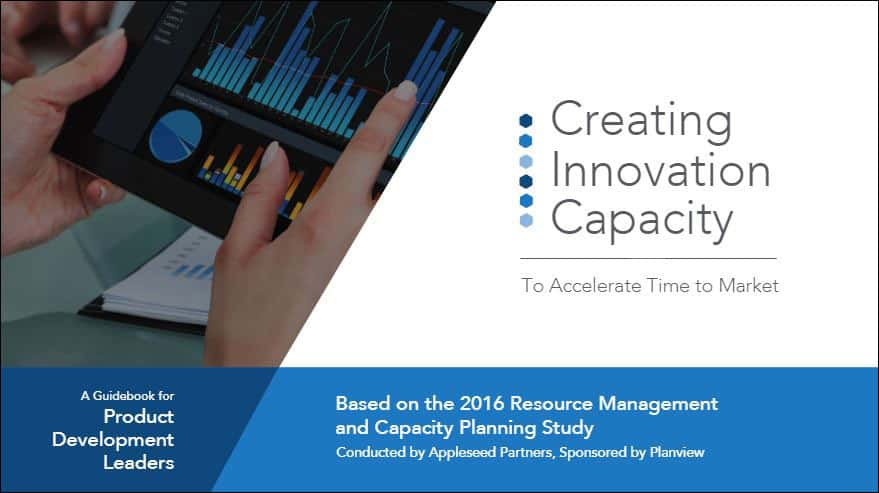
The 2016 Resource Management and Capacity Planning Benchmark Study revealed that increasingly more organisations understand the importance and value of capacity planning. The number one pain point year over year for most companies is too few resources for too many projects. Sound familiar? Innovation thrives when organisations can better plan and create innovation capacity.
Many believe innovation to be the most important element to staying competitive. Yes, innovation matters but delivering on that innovation, bringing those ideas to market—that’s when you start cooking with grease. One thing above all others stands in your way, however—resources. Behind every great product are the resources utilized to develop it. How do you accelerate innovation? Through better capacity planning.
Timing Is Everything
We love good ideas, don’t we? They inspire and get us excited about launching the next best thing since sliced bread. Ideas, however, aren’t typically the issue when it comes to product development. Ideas are everywhere and everyone thinks they have a cash cow. The only problem with ideas isn’t in generating them, it’s in knowing which ones are the right ones and then ensuring the right resources are available to deliver them.
It’s all about timing. The right resources have to be available at the right time or something’s going to get burned. Organisations have a choice: either let a good idea sit on the shelf until the resources are available, or push the idea into the already crowded funnel and start squeezing resources to fit it into their schedules. Without project prioritization or capacity planning, a product manager’s only hope is to get their project into the funnel before the next guy and hope they don’t get bumped by a squeakier wheel.
- 59% of organisations say their top risk of not improving on capacity planning is the inability to complete projects on time
- 48% of organisations are concerned about their inability to innovate fast enough
Over-committed resources are perhaps the most dangerous culprit for loss of revenue and competitiveness. Without capacity planning, there can be no project prioritization. Innovation loses its effervescence and ideas become flat.
“Organisations that excel at capacity planning are 80 percent more likely to be able to act on new opportunities in hours instead of weeks.”
The 2016 State of Resource Management and Capacity Planning Benchmark Study is the proof in the pudding that capacity planning accelerates product innovation while lowering risks. If an organisation is struggling to bring only the best ideas to market in a timely way, you can bet that over-committed resources are sabotaging progress.
Top 3 Pain Points of Product Leaders
“Delivering the right products to market on time fuels growth, yet many organisations lack confidence they can execute.”
For product leaders, ingredients matter. They have to have the quality ideas and resources in just the right amounts in order to make the magic happen. Maintaining the right mix is a balancing act that involves timing and expertise. They understand that not all ideas are good ones, even if they appear so. Not all resources are the right ones for a given project. How does a project manager ensure the right resources are combined with the right idea at just the right time? Solving this equation is a common challenge.
The top pain points of product leaders:
- Overcommitted resources
- Constant change that affects assignments
- Inability to prioritize shared resources
These pain points are stifling innovation. They are overwhelming resources. They are slowing product development and time to market. There is a secret sauce, however, that mature companies have shared so others can have a taste of the good life.
5 Steps to Create Innovation Capacity
“Higher maturity organisations reduce pain points significantly compared with their lower counterparts.”
No one likes chronic pain. Thankfully, we can learn from other companies who are doing it right and getting much needed relief. Here is a brief summary of the 5 steps higher maturing organisations are using to create innovation capacity:
- Gain visibility into pipeline demand
- Understand resource capacity
- Achieve a comprehensive view of both capacity and demand
- Conduct continuous prioritization and planning
- Run and analyze what-if scenarios
Following these steps is similar to following a recipe. You cannot skip a step and think your soufflé will turn out as it should. Capacity planning is precise, but as with any good recipe, practice makes perfect. Implementing best practices will allow the process to become repeatable and scalable as the company grows. And it will grow because it is now innovating and bringing divine products to market faster.
The benefits to capacity planning are many, not the least of which are happier resources who don’t get burned out and projects that wait their proper turn in line. While yelling may be okay in the kitchen, it has no place in the product development funnel. Prioritizing projects and resources quiets the loudest voice because everyone understands there is a standard process to get things accomplished. There is data to back up the reasoning behind prioritization and resource allocation.
Take the time to learn about capacity planning, project prioritization, and innovation. A few resources listed below will get you on the right path to maturing your organisation.
- Download the Creating Innovation Capacity eBook
- Review the 2016 State of Resource Management and Capacity Planning Benchmark Study
- Listen to the onDemand Webcast, “5 Steps for Creating Capacity for Innovation Delivery”






